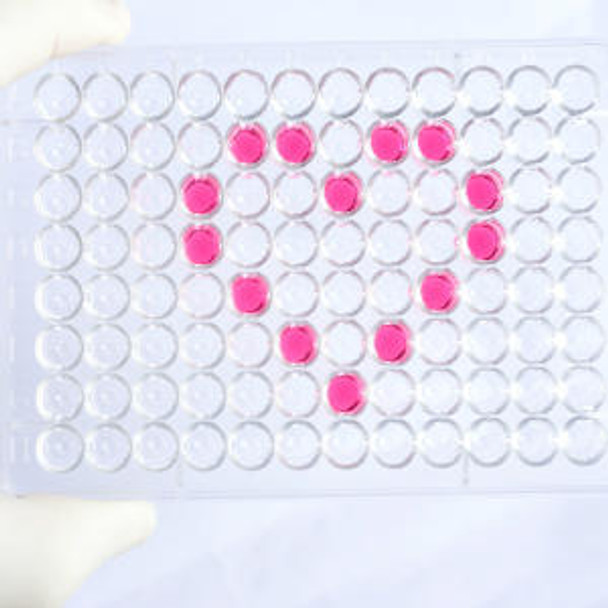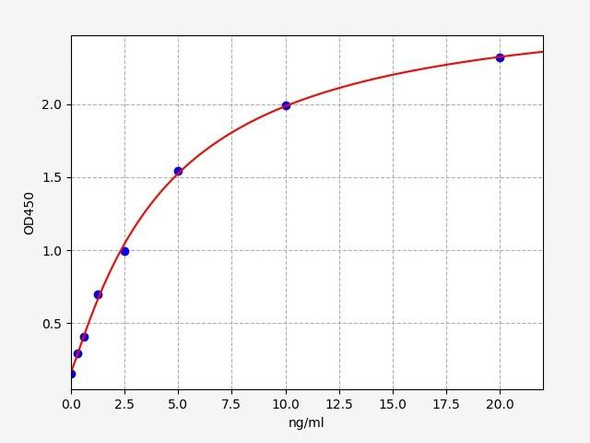Human Annexin A1 (ANXA1) ELISA Kit
- SKU:
- HUEB0593
- Product Type:
- ELISA Kit
- Size:
- 96 Assays
- Uniprot:
- P04083
- Range:
- 0.312-20 ng/mL
- ELISA Type:
- Sandwich
- Synonyms:
- ANXA1, Annexin A1, ANX1, LPC1, annexin A1, Annexin I, annexin I, lipocortin I, Annexin-1, ANX1, Calpactin II, calpactin-2, Calpactin-2, chromobindin-9, Chromobindin-9, Lipocortin I, LPC1annexin-1
- Reactivity:
- Human
Description
| Product Name: | Human Annexin A1 (ANXA1) ELISA Kit |
| Product Code: | HUEB0593 |
| Alias: | Annexin A1, Annexin I, Annexin-1, Calpactin II, Calpactin-2, Chromobindin-9, Lipocortin I, Phospholipase A2 inhibitory protein, p35, ANXA1, ANX1, LPC1 |
| Uniprot: | P04083 |
| Reactivity: | Human |
| Range: | 0.312-20 ng/mL |
| Detection Method: | Sandwich |
| Size: | 96 Assay |
| Storage: | Please see kit components below for exact storage details |
| Note: | For research use only |
| UniProt Protein Function: | ANXA1: a calcium/phospholipid-binding protein with which promotes membrane fusion and is involved in endocytosis. Has anti-inflammatory properties and inhibits phospholipase A2 activity. Accumulates on internalized vesicles after EGF-stimulated endocytosis, suggesting that it may be required for a late stage in inward vesiculation. Phosphorylated by PKC, EGFR and Chak1. Phosphorylation results in loss of the inhibitory activity. Annexins are a family of structurally related proteins whose common property is calcium-dependent binding to phospholipids. There are at least ten different annexins in mammalian species. Annexins do not contain signal peptides, yet some annexins (A1, A2 and A5) appear to be secreted in a physiologically regulated fashion. |
| UniProt Protein Details: | Protein type:Lipid-binding; Calcium-binding Chromosomal Location of Human Ortholog: 9q21.13 Cellular Component: apical plasma membrane; basolateral plasma membrane; cell surface; cornified envelope; cytoplasm; cytoplasmic vesicle membrane; early endosome membrane; endosome; extracellular region; extracellular space; extrinsic to external side of plasma membrane; extrinsic to membrane; focal adhesion; lateral plasma membrane; mast cell granule; mitochondrial membrane; nucleoplasm; nucleus; phagocytic cup; plasma membrane; protein complex; sarcolemma; vesicle Molecular Function:calcium ion binding; calcium-dependent phospholipid binding; calcium-dependent protein binding; double-stranded DNA-dependent ATPase activity; helicase activity; phospholipase A2 inhibitor activity; phospholipid binding; protein binding; protein binding, bridging; protein homodimerization activity; receptor binding; single-stranded DNA binding; single-stranded RNA binding; structural molecule activity Biological Process: actin cytoskeleton reorganization; adaptive immune response; alpha-beta T cell differentiation; arachidonic acid secretion; cell surface receptor linked signal transduction; DNA duplex unwinding; DNA strand renaturation; endocrine pancreas development; G-protein signaling, coupled to cyclic nucleotide second messenger; gliogenesis; inflammatory response; innate immune response; insulin secretion; keratinocyte differentiation; monocyte chemotaxis; muscle contraction; myoblast migration involved in skeletal muscle regeneration; negative regulation of apoptosis; negative regulation of exocytosis; negative regulation of T-helper 2 cell differentiation; neutrophil homeostasis; peptide cross-linking; phagocytosis; positive regulation of interleukin-2 production; positive regulation of neutrophil apoptosis; positive regulation of prostaglandin biosynthetic process; positive regulation of T cell proliferation; positive regulation of T-helper 1 cell differentiation; positive regulation of vesicle fusion; prostate gland development; regulation of cell shape; regulation of hormone secretion; regulation of inflammatory response; regulation of interleukin-1 production; regulation of leukocyte migration; response to drug; response to estradiol stimulus; response to peptide hormone stimulus; response to X-ray; signal transduction |
| NCBI Summary: | This gene encodes a membrane-localized protein that binds phospholipids. This protein inhibits phospholipase A2 and has anti-inflammatory activity. Loss of function or expression of this gene has been detected in multiple tumors. [provided by RefSeq, Dec 2014] |
| UniProt Code: | P04083 |
| NCBI GenInfo Identifier: | 113944 |
| NCBI Gene ID: | 301 |
| NCBI Accession: | P04083.2 |
| UniProt Secondary Accession: | P04083,P10107, |
| UniProt Related Accession: | P04083 |
| Molecular Weight: | 38,714 Da |
| NCBI Full Name: | Annexin A1 |
| NCBI Synonym Full Names: | annexin A1 |
| NCBI Official Symbol: | ANXA1 |
| NCBI Official Synonym Symbols: | ANX1; LPC1 |
| NCBI Protein Information: | annexin A1 |
| UniProt Protein Name: | Annexin A1 |
| UniProt Synonym Protein Names: | Annexin I; Annexin-1; Calpactin II; Calpactin-2; Chromobindin-9; Lipocortin I |
| Protein Family: | Annexin |
| UniProt Gene Name: | ANXA1 |
| UniProt Entry Name: | ANXA1_HUMAN |
| Component | Quantity (96 Assays) | Storage |
| ELISA Microplate (Dismountable) | 8×12 strips | -20°C |
| Lyophilized Standard | 2 | -20°C |
| Sample Diluent | 20ml | -20°C |
| Assay Diluent A | 10mL | -20°C |
| Assay Diluent B | 10mL | -20°C |
| Detection Reagent A | 120µL | -20°C |
| Detection Reagent B | 120µL | -20°C |
| Wash Buffer | 30mL | 4°C |
| Substrate | 10mL | 4°C |
| Stop Solution | 10mL | 4°C |
| Plate Sealer | 5 | - |
Other materials and equipment required:
- Microplate reader with 450 nm wavelength filter
- Multichannel Pipette, Pipette, microcentrifuge tubes and disposable pipette tips
- Incubator
- Deionized or distilled water
- Absorbent paper
- Buffer resevoir
*Note: The below protocol is a sample protocol. Protocols are specific to each batch/lot. For the correct instructions please follow the protocol included in your kit.
Allow all reagents to reach room temperature (Please do not dissolve the reagents at 37°C directly). All the reagents should be mixed thoroughly by gently swirling before pipetting. Avoid foaming. Keep appropriate numbers of strips for 1 experiment and remove extra strips from microtiter plate. Removed strips should be resealed and stored at -20°C until the kits expiry date. Prepare all reagents, working standards and samples as directed in the previous sections. Please predict the concentration before assaying. If values for these are not within the range of the standard curve, users must determine the optimal sample dilutions for their experiments. We recommend running all samples in duplicate.
| Step | |
| 1. | Add Sample: Add 100µL of Standard, Blank, or Sample per well. The blank well is added with Sample diluent. Solutions are added to the bottom of micro ELISA plate well, avoid inside wall touching and foaming as possible. Mix it gently. Cover the plate with sealer we provided. Incubate for 120 minutes at 37°C. |
| 2. | Remove the liquid from each well, don't wash. Add 100µL of Detection Reagent A working solution to each well. Cover with the Plate sealer. Gently tap the plate to ensure thorough mixing. Incubate for 1 hour at 37°C. Note: if Detection Reagent A appears cloudy warm to room temperature until solution is uniform. |
| 3. | Aspirate each well and wash, repeating the process three times. Wash by filling each well with Wash Buffer (approximately 400µL) (a squirt bottle, multi-channel pipette,manifold dispenser or automated washer are needed). Complete removal of liquid at each step is essential. After the last wash, completely remove remaining Wash Buffer by aspirating or decanting. Invert the plate and pat it against thick clean absorbent paper. |
| 4. | Add 100µL of Detection Reagent B working solution to each well. Cover with the Plate sealer. Incubate for 60 minutes at 37°C. |
| 5. | Repeat the wash process for five times as conducted in step 3. |
| 6. | Add 90µL of Substrate Solution to each well. Cover with a new Plate sealer and incubate for 10-20 minutes at 37°C. Protect the plate from light. The reaction time can be shortened or extended according to the actual color change, but this should not exceed more than 30 minutes. When apparent gradient appears in standard wells, user should terminatethe reaction. |
| 7. | Add 50µL of Stop Solution to each well. If color change does not appear uniform, gently tap the plate to ensure thorough mixing. |
| 8. | Determine the optical density (OD value) of each well at once, using a micro-plate reader set to 450 nm. User should open the micro-plate reader in advance, preheat the instrument, and set the testing parameters. |
| 9. | After experiment, store all reagents according to the specified storage temperature respectively until their expiry. |
When carrying out an ELISA assay it is important to prepare your samples in order to achieve the best possible results. Below we have a list of procedures for the preparation of samples for different sample types.
| Sample Type | Protocol |
| Serum | If using serum separator tubes, allow samples to clot for 30 minutes at room temperature. Centrifuge for 10 minutes at 1,000x g. Collect the serum fraction and assay promptly or aliquot and store the samples at -80°C. Avoid multiple freeze-thaw cycles. If serum separator tubes are not being used, allow samples to clot overnight at 2-8°C. Centrifuge for 10 minutes at 1,000x g. Remove serum and assay promptly or aliquot and store the samples at -80°C. Avoid multiple freeze-thaw cycles. |
| Plasma | Collect plasma using EDTA or heparin as an anticoagulant. Centrifuge samples at 4°C for 15 mins at 1000 × g within 30 mins of collection. Collect the plasma fraction and assay promptly or aliquot and store the samples at -80°C. Avoid multiple freeze-thaw cycles. Note: Over haemolysed samples are not suitable for use with this kit. |
| Urine & Cerebrospinal Fluid | Collect the urine (mid-stream) in a sterile container, centrifuge for 20 mins at 2000-3000 rpm. Remove supernatant and assay immediately. If any precipitation is detected, repeat the centrifugation step. A similar protocol can be used for cerebrospinal fluid. |
| Cell culture supernatant | Collect the cell culture media by pipette, followed by centrifugation at 4°C for 20 mins at 1500 rpm. Collect the clear supernatant and assay immediately. |
| Cell lysates | Solubilize cells in lysis buffer and allow to sit on ice for 30 minutes. Centrifuge tubes at 14,000 x g for 5 minutes to remove insoluble material. Aliquot the supernatant into a new tube and discard the remaining whole cell extract. Quantify total protein concentration using a total protein assay. Assay immediately or aliquot and store at ≤ -20 °C. |
| Tissue homogenates | The preparation of tissue homogenates will vary depending upon tissue type. Rinse tissue with 1X PBS to remove excess blood & homogenize in 20ml of 1X PBS (including protease inhibitors) and store overnight at ≤ -20°C. Two freeze-thaw cycles are required to break the cell membranes. To further disrupt the cell membranes you can sonicate the samples. Centrifuge homogenates for 5 mins at 5000xg. Remove the supernatant and assay immediately or aliquot and store at -20°C or -80°C. |
| Tissue lysates | Rinse tissue with PBS, cut into 1-2 mm pieces, and homogenize with a tissue homogenizer in PBS. Add an equal volume of RIPA buffer containing protease inhibitors and lyse tissues at room temperature for 30 minutes with gentle agitation. Centrifuge to remove debris. Quantify total protein concentration using a total protein assay. Assay immediately or aliquot and store at ≤ -20 °C. |
| Breast Milk | Collect milk samples and centrifuge at 10,000 x g for 60 min at 4°C. Aliquot the supernatant and assay. For long term use, store samples at -80°C. Minimize freeze/thaw cycles. |









